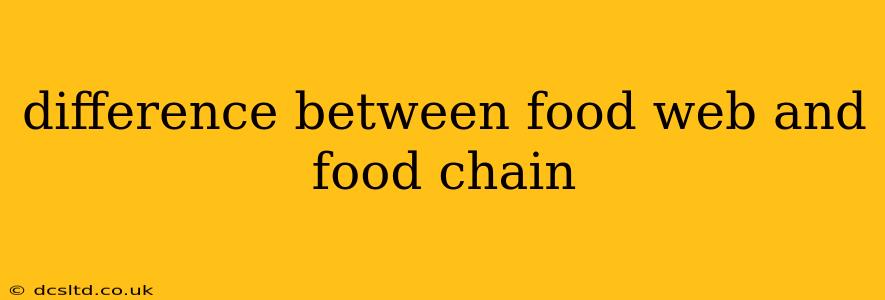The Difference Between a Food Web and a Food Chain: Understanding Nature's Interconnectedness
The terms "food chain" and "food web" are often used interchangeably, but they represent different aspects of the complex relationships within an ecosystem. While both illustrate the flow of energy through an ecosystem, they differ significantly in scope and complexity. Understanding this difference is crucial to appreciating the delicate balance of nature.
What is a Food Chain?
A food chain is a linear sequence illustrating the transfer of energy and nutrients from one organism to another. It starts with a producer (like a plant) that creates its own food through photosynthesis, then moves to a primary consumer (herbivore) that eats the producer, followed by a secondary consumer (carnivore) that eats the herbivore, and so on. This continues until a top predator or apex predator is reached. A simple example: grass → grasshopper → frog → snake.
This linear structure, while illustrative, simplifies the intricate reality of ecological interactions. It represents only one possible pathway of energy flow.
What is a Food Web?
A food web is a much more complex and realistic representation of the interconnected feeding relationships within an ecosystem. It’s a network of interconnected food chains, showing how multiple organisms interact and depend on each other for sustenance. Instead of a single linear path, a food web shows a multitude of paths, reflecting the fact that many organisms consume a variety of food sources and, in turn, serve as food for multiple other organisms.
For example, a grasshopper might be eaten not just by a frog, but also by a bird. The frog itself might be eaten by a snake or a heron. This intricate network showcases the true complexity of an ecosystem. It highlights the interdependence of species and the cascading effects that can result from changes within the web.
What are the key differences between a food web and a food chain?
| Feature | Food Chain | Food Web |
|---|---|---|
| Structure | Linear sequence | Network of interconnected food chains |
| Complexity | Simple | Complex |
| Realism | Oversimplification of ecological reality | More accurate representation of ecosystem dynamics |
| Number of paths | Single pathway of energy flow | Multiple pathways of energy flow |
| Interdependence | Shows limited interdependencies | Shows extensive interdependencies between species |
How does a change in one part of a food web affect the whole ecosystem?
A change in one part of a food web, such as the decline of a key species (e.g., a keystone species), can have dramatic ripple effects throughout the entire system. For example, if the population of rabbits (primary consumer) decreases significantly, it can impact the population of foxes (secondary consumer) that rely on them for food. This, in turn, can affect other species within the food web, leading to imbalances and potential ecosystem instability.
What are some examples of food chains and food webs?
Food Chain Example: Phytoplankton → Zooplankton → Small Fish → Larger Fish → Shark
Food Web Example: Consider a forest ecosystem. A food web would include trees (producers), insects feeding on the trees, birds eating insects, larger birds or mammals eating the smaller birds, decomposers breaking down dead organisms, and so on – all intricately linked.
In conclusion, while a food chain provides a basic understanding of energy flow, a food web offers a far more comprehensive and accurate depiction of the complex interactions and interdependence within an ecosystem. Understanding the differences is crucial for appreciating the fragile balance of nature and the importance of conservation efforts.
